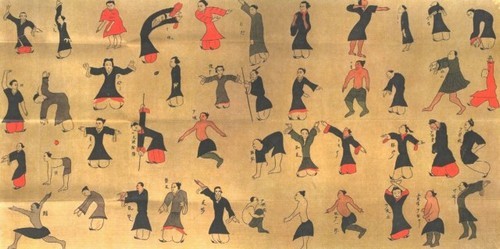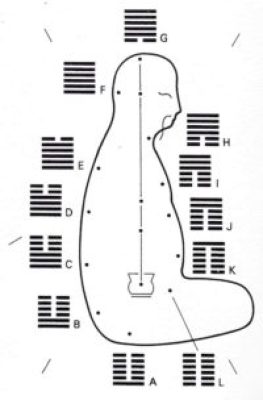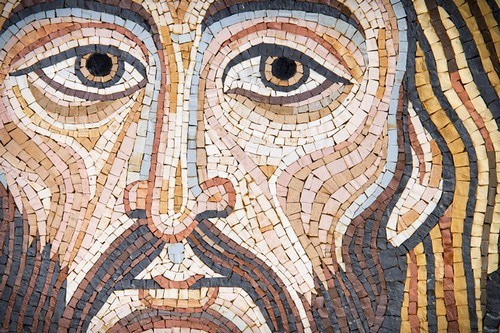The article deals with the application of the principle of dominant Alexei Ukhtomsky to interpret the psychology of Chinese qigong on the example of the categories “and” (意) and “Xin” (心).
Because the Chinese and, more broadly, Eastern practices of body and mind is widely spread in modern society, it makes sense to explore them, to clarify the sources of their effectiveness and to interpret traditional formed within specific cultural terms in the language of universal scientific categories.
Currently we can distinguish two poles in the approaches to the understanding of Eastern (mainly Chinese related to qigong and Taoist tradition) practices in “Western” discourse.
At one extreme are attempts fully as possible without much change to move a historically formed the terminology and all the associated range of ideas. This approach has a lot to take on faith, to consider certain traditional comments are not as metaphors, but as literal instructions. This approach can be called the “mythologizing”, because it inevitably leads to the need to interpret certain phenomena in the context of a closed conceptual field tradition that does not lead to enhanced understanding of these phenomena, but only to the confirmation in the consciousness of the adept of allegiance to the chosen myth.
At the other extreme are attempts to deny any useful content in the categories, ideas, and metaphors of the traditional definitions of Eastern practices, reduction of the relevant phenomena to physiological processes and States that can be fully understood in the framework of modern natural-scientific picture of worlds – and therefore do not need additional categories for their interpretation. This approach can be roughly described as “depreciation”. Between these two poles are various attempts to interpret Eastern psycho in the language of Western science and culture. Such attempts to combine the attention and respect of themselves to the traditional terms and texts to search for Parallels, analogies and interpretations in the universal categories of Humanities and natural Sciences.

Such an interpretation, on the one hand, allows the practitioner to better understand the meaning and significance of mastering methods and techniques, and to avoid vague wording, which can serve as a basis for speculation and myth-making. On the other hand, it contributes to the construction of a single conceptual field, to develop the dialogue of cultures and may lead to the clarification of the universal foundations of human consciousness.
Interpretation of the Eastern psycho in the language of Western science and culture can contribute to clarify the universal foundations of human consciousness
As a productive example of such interpretation can result in the classic work of Carl Jung, who in part developed the conceptual apparatus of analytical psychology, explored the similarities and differences of language and semantics the Western and Eastern approaches to working with consciousness and pointed (particularly in the “Yoga and the West”) on the capabilities and limitations of the perception and use of the Western man of the East (Indian and Chinese) practices.
The exponential growth of the popularity of these practices in the 60-ies of the last century in Western society has caused a response from many researchers who sought to develop and develop a methodology for understanding them. An example would be the concept of cartography of the unconscious Stanislav Grof, who in his model synthesized the diverse phenomenology of the experiences and States of consciousness, known as from traditional sources (Eastern and Western), and of them drawn from his own psychotherapeutic practice. Based on extensive factual material, he created a three-tiered model of the psyche, highlighting her personal, perinatal and transpersonal levels (Grof, 2008).
However, it gives little attention to the analysis of tools of regulation and self-regulation of the relevant States of consciousness, the emphasis is on their spontaneous experience and transformation under the influence of external in relation to consciousness of the factors (psychoactive drugs or holotropic breathing, which leads to certain biochemical processes, inducing an altered state of consciousness).
On the contrary, the regulation of States of consciousness has given considerable attention to Charles tart (whose iconic work has been published around the same time as the works of Grof) who developed a systematic approach to States of consciousness, in which, through the provision of discrete States of consciousness, was implemented the possibility to clarify their hierarchy, nature of their relationship, mechanisms of influence and control in the system of States of consciousness (Tart, 2001).
Because of the nature of the historical process of such studies on domestic soil were until recently much less widespread. However, we should mention the work of Dmitry L. Spivak, which allowed to reveal the peculiarities of the languages altered States of consciousness (Spivak, 2000), Vasily Nalimov, who built a probabilistic oriented semantic model of the human personality and States of consciousness (Nalimov, 1989), and Oleg G. bakhtiyarova, which develops the model of “active consciousness”, in which interpreted the Western and Eastern psycho (Bakhtiyarov, 2010).
In this paper we attempt to interpret some of the Chinese qigong psychology with the application of the principle of dominant Alexei Ukhtomsky (Ukhtomsky, 1966), showing its possibilities to clarify these practices, in terms of structures and States of consciousness of the practitioner.
The problem of the emergence and implementation of hierarchical relationships in the human psyche revealed in the doctrine of the dominant and functional on Ukhtomsky.

As he wrote Ukhtomsky, “dominant in physiology – temporarily dominating reflex, which transformered and sent for a given time, ceteris paribus, the work of the other reflex arcs and reflex apparatus of the whole” (Ukhtomsky, 1966). “The external expression of the dominant is stationary supported work or working position of the body.” It is the dominant defines the hierarchy of action of the organism (the unity of mind and body) for solving a particular problem.
Moreover, the dominant feature not only creates a certain point of excitation (from the point of view of neurophysiology in the cortical area of the brain), but also slows and organizes different reactions at different levels, not associated with the task. The system acts as a dominant factor. According to Ukhtomsky, “the dominant is in full swing there is a complex of certain symptoms throughout the body – in muscle, and in secretory job, and vascular activities. So it would seem rather as a constellation of centers with increased excitability in various floors of the brain and spinal cord and the Autonomous system.”
For Ukhtomsky principle that the dominant is not a morphological formation that are linked to certain anatomical structures. It is a dynamic unity, asked occurring and supported in the process of guided activities hierarchical relationships between different centers of the body. Ukhtomsky considers such dynamic unity as a “functional body”: “body can be, in my opinion, and from my point of view, every combination of forces that could lead, ceteris paribus, every time the same results”. Thus, the “functional body” as an expression of the dominant is gemorphological, energy (“interplay of forces”) the tumor, causing the body (as a unity of mind and body) to the solution of the problem.
In Russian psychology idea of the Ukhtomsky dominant and functional on also influenced the work of Lev Semenovich Vygotsky in the construction of the notions of consciousness as the structural-dynamic unity “lower” or natural, and “higher” mental functions, which are formed as “dominant” and “functional bodies” in the process of learning by the individual cultural and historical experience through the mechanism of internalization (Vygotsky, 1982). In some modern works of domestic psychologists (Gordeev, 2009; Slavnov, 1995) understands the classification izmenennykh States of consciousness described in the works of Ukhtomsky and Vygotsky’s principle of hierarchy, are considered “tumors” which may be interpreted as a new “functional bodies”, as “higher mental functions” in relation to spontaneously occurring “natural” altered States of consciousness.
Productive use of dominant categories and “functional body” not only for the study of States of consciousness, but also for understanding the mechanism of hierarchy and transformation of these conditions in traditional practices, cultivating them, for example, in the psychology of the Chinese system of qigong.
Qigong as an institutionalized set of practices emerged during the second half of the twentieth century under the influence of ideological attitudes of the CCP (and personally of Mao Zedong), in the period before the cultural revolution in China, when searched for “folk” as an effective method for improvement of the masses of workers. However, the source of practices used in modern qigong have become traditional methods and approaches known in China since antiquity (Chosen Lin, 1995).
This relates to the idea of “the three treasures” (sanbao, 三宝), which expresses the idea of the unity of body and mind. In fact, Jing indicates “essence”, physical, material substrate and the source of life. Its content is interpreted differently in different Chinese authors (Yang sungmin, 2004), but there is always the appeal to the bodily component. Qi is associated directly with the breath (as indicated by and corresponding to the character 气, also denoting air) or with a hypothetical life force, guiding him (Hoshen Lin, 1995; Yang sungmin, 2004).
One of the three treasures (Jing-qi-Shen, 精气神) in Chinese qigong is 神 (Shen). Like all concepts of Chinese culture, it has many meanings that are applied depending on the context. From the point of view of qigong practices, its possible value is the integrity of consciousness, a criterion of achievement of integration, which is a balancing act, a harmonization of the entire psychosomatic nature of the individual, i.e. 气 (qi) and 精 (Jing) (Yang sungmin, 2004).
“Training” Shen is based on the cultivation of specific States of consciousness associated with the use and (意), defined as “a strong-willed mind, the power of intention, the mind of wisdom” as “dominant” in relation to another factor – Xin (心).
Blue – a spontaneous, emotionally colored, but not consciously directed (not “coherent”) state of consciousness. And being a “mind of wisdom and freedom”, is the source of discriminating understanding and conscious intention.
And is “dominant” in relation to blue, its formation as a functional organ is the cause and source of integration of the Shen (and the whole psychosomatic human nature). The relevance of this interpretation specifies the structural analysis of the character I. In fact, this character , consists of three parts. It forms the basis of his character Xin (心), the value of which has already been discussed above. The second level forms the character Yue (曰) is set to “speech, talk”. Finally, the third and the topmost level of the character Li (立), with a value of “install”.
In the ordinary state of consciousness “the emotional mind” responds to a chaotic set of incentives without any order and sequence, without internal logic and steady course. So he generates a lot of uncontrollable, flowing into each other States. However, there is a factor of consciousness, which with proper cultivation and development turns into “dominant” and “functional body”, regulating the stream of consciousness and achieve the integration of its States. In Chinese tradition this is reflected in the proverb Xin HOU and mA (心猴意马) – “heart like a monkey, and the mind – horse” (Jan sungmin, 2004).
According to Chinese sources, the practical meaning of meditation is and Xin Hui and (意心匯意) – transformation of “emotional intelligence” to match the “mind of wisdom”, in the words of Yan Sungmin (Ian tszyunmin, 2004).
According to Chinese sources, the practical meaning of meditation is the transformation of the “emotional intelligence” to match the “mind of wisdom”
Regular cultivation of this type of altered state of consciousness leads to the formation and application of special “functional organ” as a means of integrating mind and body in traditional qigong practice. In the Chinese Taoist traditions and in contemporary qigong there are different keys and patterns of such integration.
Consider the most common basic practices: first, in traditional Chinese sources, and then through the interpretation in psychological terms and the language of the concept of dominant ukhtomskii.

The development of any practice, whether the motor sequence (taolu) Taijiquan, or interact in the framework of the “external” martial arts, or practice dynamic qigong requires the initial ability to achieve and maintain a state of rest of the heart (an Xin 安心). So adept of any martial arts, especially qigong practices, with the need to develop methods of achieving it. First of all, he trains in the achievement of a state of peace consciousness in a particular body position, which is seen as a “basic front”, most relevant to the task of “training” dormancy (van Suance, John Moffet, 2006).
Static work with a straightened spinal column forms, on the one hand, the possibility of observing States of mind, emotions and body, and on the other hand, in contrast to the practices sitting or lying down, provides the subsequent transition to the movements in the proper state of consciousness. And traditional sources it is accepted to speak about the “high work”, Zhong Zhuang (中桩), and not just about “standing”. This is really a job that requires a special way of directed attention, constant fine-tuning of the position of the body. “Pillar working” is a basic practice and as an integral part of many schools of martial arts and qigong.
There are many sources that describe the role and importance of this practice (Chosen Lin, 1995; Yang sungmin, 2004; van Suance, John Moffet, 2006). Here, as an example, from an authentic source, the interpretation of this method by the famous van Senjem (1885 – 1963), the founder of the school of yiquan, practicing pole work with rannego age. Van Sanji, being a student of a famous xinyiquan master (Guo Yongsheng) in childhood did not differ strength and health, however, proved an apt pupil, and in adolescence reached great heights in the xinyiquan, and in the other internal arts (Bahagian).
From a young age he used “pole work” (and the practice lasted more than an hour) as a necessary base to achieve the proper state of consciousness and the amplification of “energy” required for the development of practices and patterns in martial arts. Later creating his own style of “internal” martial art, yiquan, and became a famous master in the Chinese world, he acted as a living example and advocate the need for “pole work” as a natural and effective framework of any practice. Largely under his influence, the elements of “highway works” an integral part of qigong (Chosen Lin, 1995).
The following is a description of this practice by van Senjem:
“When you practice, first you should adopt proper posture. The mind should be clear, without worry. Be naturally relaxed, keep your head straight, eyes looking straight ahead, the body in the correct position, as if it hung over the top. The spirit of serious, power is balanced, the breath is calm, you look away, Talia relaxed, all joints slightly bent, the disturbing thoughts go, you silently stand in a huge space. The mind runs outside, external matters do not penetrate into the spirit shines, you feel amazing agility, as if you were alone in the universe, the hair on your body as if stretched and standing up. All my body seems to be pulsing. You like a huge, precious, beautiful tree that reaches the clouds. You as if suspended from above and supported from below. This state of mind can be compared to swimming through the air. Your experience, your experience gently pulsing in every cell of the body. After some time the condition will be the natural state of motion” (van Sanji, “the Central axis of the way of the fist”).
Van Sanjay identified four key criterion for the right “pillar work.” These include correct body position (with properly straightened spinal column), proper relaxation (which does not lead to full muscle relaxation, allows to keep the structure correct posture and exercise at any moment the transition to directional movement), correct observation (which includes the distribution of attention between different areas of the body and the outer circle – sound, visual stimuli in the periphery of consciousness) and breathing (continuous, accelerated, coherent).
From the point of view of psychotechnical work these characteristics, first, native-Jung Chuang of “deconcentration of consciousness and volitional meditation” approach bakhtiyarova. Indeed, the process of deconcentration of consciousness, including at the expense of switching attention of the subject on the peripheral field of vision (either on the periphery of perception auditory signals), is achieved by the calming of consciousness, the cessation of verbal ratings of the stimuli. This forms the basis for the subsequent concentration on consciousness in real time, which is, in Bakhtiarova, “attractor” for the formation of a new “functional system” of consciousness. In the practice of “highway works”, the subject gets the experience of deconcentration of consciousness, if it follows the above criteria for its correct execution, and creates opportunities for “informed” subsequent psycho-physical practices.
In the “high work” the subject gains experience deconcentration of consciousness and creates conditions for “informed” subsequent practices
With that said, you can also interpret the “high work” in the language of the concept of Ukhtomsky. Self alignment of the body vertically and maintaining it in accordance with the foregoing principles creates and develops new dominant (recall the above remark Ukhtomsky about the significance of bodily postures for the formation of the dominant), and regular practice leads to the development of a new “functional body”.
Thus, the most basic practice of the Chinese tradition, lays the Foundation for further psychophysiological work, formed a special “dominant”, and then “functional body”, leading to the transformation of the contents and States of consciousness of the practitioner. The use of “dominant principle” Ukhtomsky is a useful tool in the interpretation of the psycho Chinese qigong and allows you to get closer to understanding some aspects of their impact on the consciousness of the practitioner.
Literature
- Bakhtiyarov O. G. Deconcentration. M, Nika-Tsentr, 2004.
- Bakhtiyarov O. G. Active consciousness. M., POSTHUMOUS, 2010.
- Van Sanji. The true path of Yiquan. M., Russian center of Yiquan, 2011.
- Van Sanji. The Central axis of the way of the fist, the b/I.
- Van Suance, Moffett John. Juangon. Kiev, 2006.
- Vygotsky L. S. the psychological systems / collected works, vol. 1. M., 1982.
- Gordeeva O. V. Altered States of consciousness and culture: a reader. SPb., 2009.
- S. Grof Journey in search of himself. M., AST, 2008.
- Nalimov V. V. Spontaneity of consciousness. Probabilistic theory of meanings and semantic architectonics of personality. M., Prometheus, 1989.
- Slavnov, S. V. Personality in altered States of consciousness: psycho-semantic approach. M., Moscow state University, Department of psychology, 1995.
- Spivak D. L. Altered States of consciousness: psychology and linguistics / edited by academician N. P. Bekhtereva. SPb., Juventa publishing House; Philological faculty St. Petersburg state University, 2000.
- Ukhtomsky A. A. Dominanta. Moscow-Leningrad, “Nauka”, 1966.
- Chosen Lin, Lo Paul. The secrets of Chinese medicine. 300 questions on qigong, Novosibirsk, “Nauka”, Siberian publishing firm of RAS, 1995.
- C. G. Jung, Yoga and the West. M., Initiative, AirLand, 1994.
- Ian Tszyunmin. The roots of Chinese qigong. The secrets of successful practices. M., “Sofia”, 2004.
- Tart C. T. States of Consciousness. NY, 2001.



